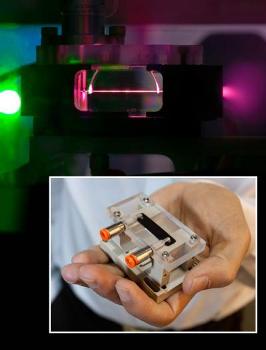Scientists of Berkeley Lab have discovered high quality, strong electron beams useful in laser plasma applications.
 Table top laser
Table top laser
It is important that laser plasma accelerators generate stable electrons of high quality and adjust those beams to cater to the requirements of the users. The US department of energy at the Berkeley Lab conducted the LOASIS program to illustrate superior quality beams of nearly a billion electron volts in just 3.3 cm and it is anticipated that the BELLA project will attain 10 billion eV in one meter.
Wim Leemans, head of the LOASIS program, Berkeley Lab’s Accelerator and Fusion Research Division, uses the analogy of a surfer riding in a wave to explain the working of the plasma accelerator. When the waves from the laser pulse are applied to the plasma, the oppositely charged nuclei and the electrons build up the electric field. Some of the electrons gain high energy due to being carried away by the waves.
Efforts to create tunable electron beams using the principle of momentum matching have been attempted by introducing electrons into the accelerating field. Experiments were conducted by modifying the 40 trillion watt peak power drive laser and the 3.3 cm LOASIS accelerator at the Berkeley Lab to obtain a beam of power, billion electron volts. The accelerator is a titanium sapphire block with a fine capillary filled with plasma-ionized hydrogen gas, ionized by an electricity jolt prior to the introduction of the drive laser pulse. The LOASIS system is modified to suit double-stage tunable acceleration by making a supersonic helium gas jet to pass through the hydrogen-filled capillary, increasing electron density, thereby reducing the plasma density.
By fine-tuning the plasma density in two zones along the accelerator length, the LOASIS researchers were able to achieve a tunable electron beam ranging from 100 million eV to 400 million eV, at the same time maintaining the energy in a stable position within a small percentage.